Water and Wastewater Engineering
Подождите немного. Документ загружается.

18-28 WATER AND WASTEWATER ENGINEERING
18-3. The town of Northfield provides wastewater treatment for a community of 10,000
and two colleges, each with a population of 5,000. In examining the flow data, what
time periods in the annual cycle of flows will be important for identifying extreme
flow rates?
18-10 REFERENCES
Ahmad, R. (2002) “Watershed Assessment Power for Your PC,” Water Environment & Technology,
April, pp. 25–29.
ASCE (1982) Gravity Sewer Design and Construction, American Society of Civil Engineers and Water
Pollution Control Federation, Reston, Virgina, pp. 37, 123.
Census (2006) at http://www.census.gov .
Federal Register (1974), vol. 39, no. 29, section 35.905, February 11th.
GLUMRB (2004) Recommended Standard for Wastewater Facilities, Great Lakes–Upper Miss
issippi
River Board of State and Provincial Public Health and Environmental Managers, Health Education
Services, Albany, New York.
H utson, S. S., N. L. Barber, J. F. Kenny et al. (2001) Estimated Use of Water in the United States in 2000,
U.S. Geological Survey Circular 1268, Washington, D.C., http://www.usgs.gov .
L yon, T. and R. Nelson (2002) “Sewer Design Practices,” Water Environment and Technology, March,
pp. 21–25.
Metcalf & Eddy (1981) Wastewater Engineering: Collection and Pumping of Wastewater, McGraw-Hill,
New York, pp. 61–95.
Metcalf & Eddy (2003) Wastewater Engineering: Treatment and Reuse, M cGraw-Hill, Boston,
pp. 154–170, 452.
U.S. EPA (1992) Environmental Regulations and Technology: Control of Pathogens and Vector
Attraction in Sewage Sludge, U.S. Environmental Protection Agency Publication No. EPA/625/R-
92/013, pp. 18–30.
U.S. EPA (2005a) http://www.epa.gov . Search: Region 10 Homepage NPDES
Permits Current NPDES Permits in Pacific Northwest and Alaska Current Individual
NPDES Permits in Idaho.
U.S. EPA (2005b) http://www.epa.gov/owow/tmdl/intro.html and http://www.epa.gov/waterscience/
models/allocation/def.html .

19-1
19-7 SEWER SAFETY
19-8 CHAPTER REVIEW
19-9 PROBLEMS
19-10 DISCUSSION QUESTIONS
19-11 REFERENCES
SANITARY SEWER DESIGN
19-1 INTRODUCTION
19-2 PREDESIGN ACTIVITIES
19-3 GRAVITY SEWER COLLECTION
SYSTEM DESIGN
19-4 ALTERNATIVE SEWERS
19-5 PUMP STATION DESIGN
19-6 OPERATION AND MAINTENANCE
19
CHAPTER

19-2 WATER AND WASTEWATER ENGINEERING
19-1 INTRODUCTION
The design of a sewer system generally includes the following steps: preliminary investigations,
a detailed survey, the actual design, and preparation of final drawings. With the addition of a
discussion of sewer nomenclature, appurtenances, and confined space safety issues, these topics
form the outline of this chapter.
Nomenclature
The various types of sewers in a typical wastewater collection system are described in Table 19-1
and are illustrated in Figures 19-1 and 19-2 .
The nomenclature of a typical sewer pipe with a bell and spigot joint is shown in Figure 19-3
on page 19-5 .
Appurtenances
Manholes. Manholes are the most familiar appurtenance of a wastewater collection system.
Although they have been built of brick and cast in place, current practice is to use precast con-
crete. The standard manhole ( Figure 19-4 on page 19-5 ) and the drop manhole ( Figure 19-5 on
page 19-6 ) are the typical configurations. The d
rop manhole is used when the inflow and outflow
sewers differ in elevation by more than 0.6 m. This protects the workers who must enter from
inadvertently taking a shower while they work. It also reduces volatilization of odoriferous com-
pounds. The entire outside of the drop connection is encased in concrete to minimize differential
settlement pressures between the drop pipe and the manhole that may fracture the connection.
The manhole cover is always round to prevent it from falling into the manhole. Current prac-
tice is to use a solid cast iron or ductile iron cover. The c over should not be perforated bec ause
of the potential for inflow from storm water. This also minimizes escape of odors. When there
is potential for the manhole to be submerged, the cover is provided with a ga
sket and is bolted
down. Alternatively, if the manhole is not in a roadway, the manhole may be constructed so that
the top is above flood level.
TABLE 19-1
Nomenclature of sewers in a typical collection system
NameDescription
Lateral Lateral sewers form the first element of a wastewater collection
system. They collect the wastewater from buildings and convey
it to a main sewer.
Main The main sewer conveys wastewater to trunk sewers or intercepting
sewers.
Force main This term is used to describe a pressurize
d pipe that is used to convey
wastewater.
Trunk Trunk sewers are large diameter sewers that are used to convey wastewater
from main sewers to treatment facilities or to intercepting sewers.
Interceptor The interceptors are very large diameter sewers that are used to intercept
a number of main or trunk sewers an
d convey wastewater to treatment
facilities.
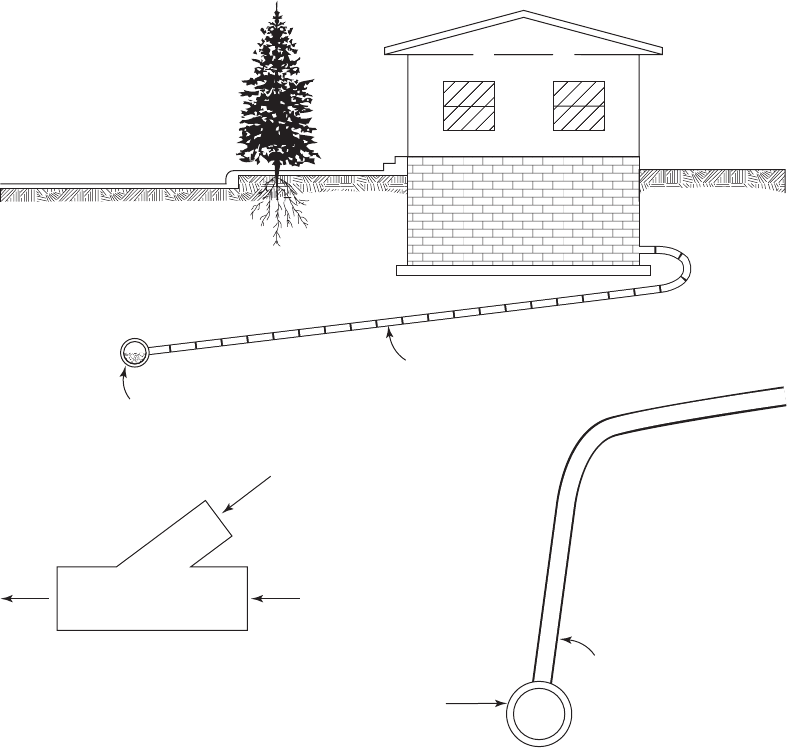
SANITARY SEWER DESIGN 19-3
Main
Riser
For deep connection
to lateral
Lateral
Lateral
Sewage flow
Wye
Connection to main
Lateral
Main
Street
FIGURE 19-1
Lateral with exploded view of wye connection to main and an alternative connection for a deep main.
Lift Stations and Pumping Stations. Several conditions result in the necessity to pump sewage
in a gravity collection system. These include but are not limited to the following cases:
• Flat terrain. Long pipe ru ns to reach the wastewater treatment plant may result in sewers
that are very deep. At some point, either the angle of repose of the soil limits the excavation
perpendi
cular to the sewer because of available space or the cost of further excavation is
prohibitive.
• Hilly terrain. When hills present an obstacle that cannot be circumvented by gravity flow,
the wastewater may be pumped over the obstacle.
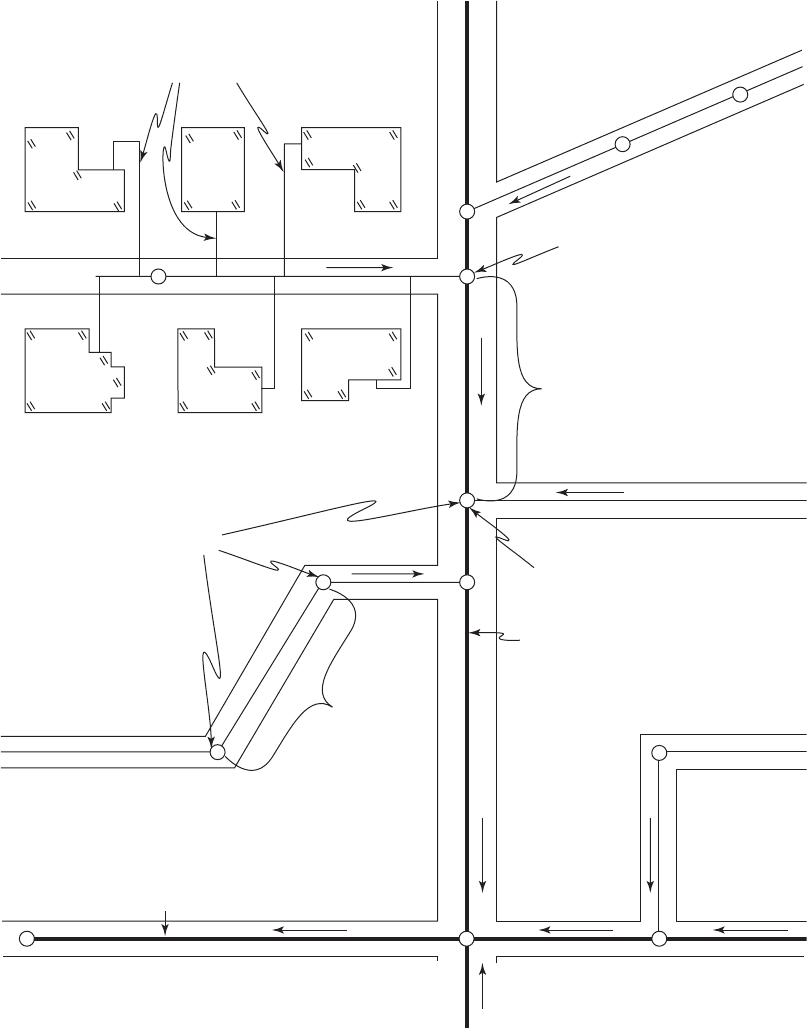
19-4 WATER AND WASTEWATER ENGINEERING
Laterals
Manholes
Upper manhole or
upstream manhole
Reach
Reach
Lower manhole or
downstream manhole
Force main sewer
Interceptor sewer
Main
Trunk sewer
Main
FIGURE 19-2
Nomenclature of sewers.
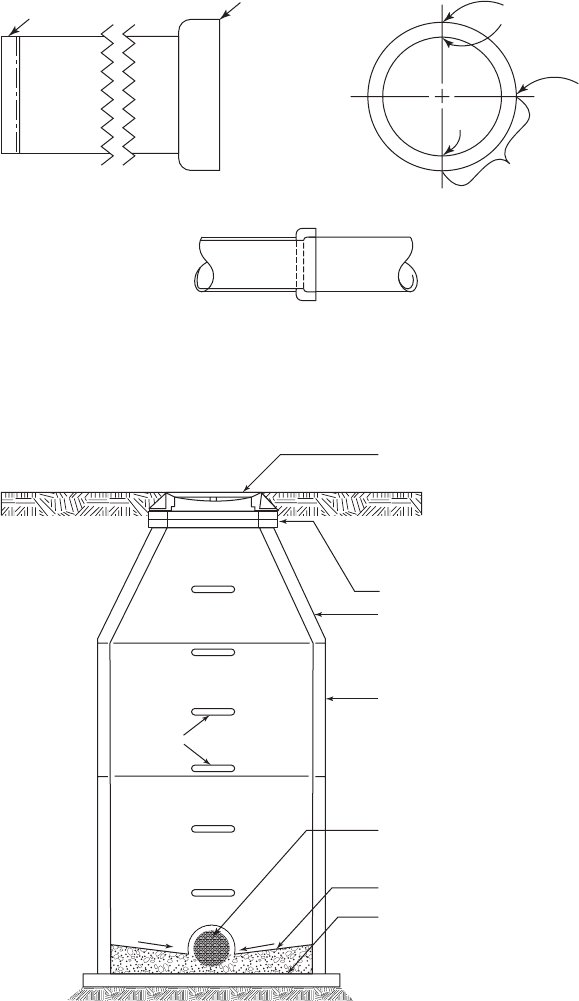
SANITARY SEWER DESIGN 19-5
Spigot
Bell
Crown
Spring line
Invert
Haunch
Bell and spigot joint
FIGURE 19-3
Nomenclature of a sewer pipe.
Cover & frame
Grade rings
Cone
Walls
Steps
Benches
Base slab
Flow channel
FIGURE 19-4
Manhole nomenclature.
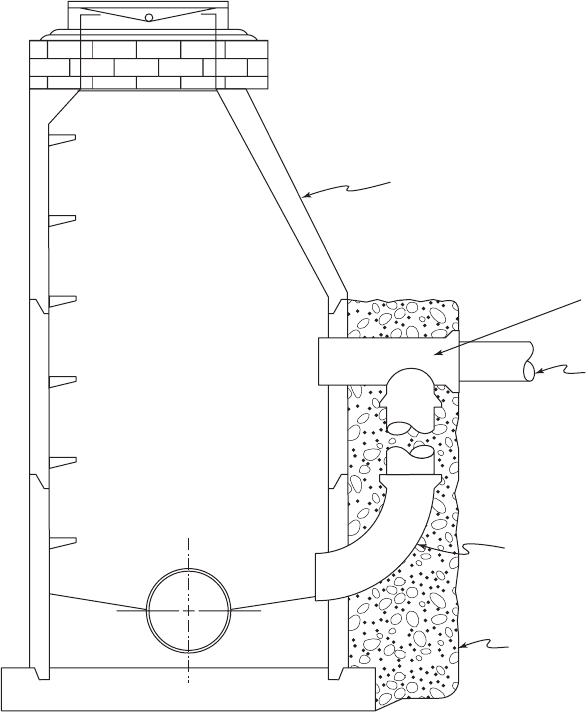
19-6 WATER AND WASTEWATER ENGINEERING
Class ‘A’ concrete
encasement—15 cm all around
Long radius premium joint 90° elbow
Inlet sewer
Ductile iron pipe (DIP)
See typical manhole detail (Figure 19-4)
FIGURE 19-5
Drop manhole detail.
• Obstacles. Bedrock, for example, may limit the depth of the sewer.
• Groundwater. When the depth of the s ewer places it below the groundwater table, it may
be desirable to raise the sewer grade by pumping. This condition is often encountered when
sewers are to be provided for lakefront property.
In these instances, the sewage may be lifted to a higher elevation by pu
mping. Thus, these
pumping stations are called lift stations. Conventional pumping stations similar to those used
for low service water pumping are constructed when the flow rates are high or where the waste-
water must be screened. Factory-assembled, or package pumping stations, such as that s
hown in
Figure 19-6 are used for smaller flows.
The discharge from the pumping station may be to either another gravity sewer with a higher
invert than the incoming sewer or to a force main.
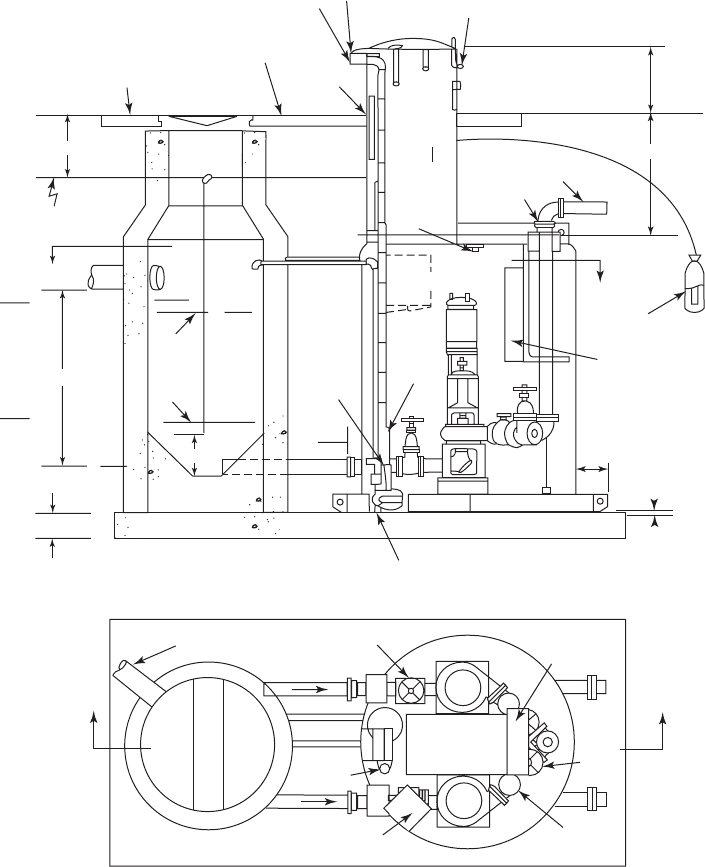
SANITARY SEWER DESIGN 19-7
Concrete slab
Suction
Sump pump
Section A—A
150 mm
Elevation
Varies
Elevation
HHA
(Start pumps
& sound alarm)
LLW
(Stop pumps
and sound alarm)
Influent
Flood elev.
A
HWL
LWL
0.6 m min.
Ground line
Standard cover
Typical
wet-well
Concrete walk
(optional)
Mastic
Air vent
Spring-loaded
hinge
Lock with
inside
release
Elevator service entrance
(end of sta.)
End of
sta.
Force main
0.6 m
typical
Variable
A
Ladder
Lights
Entrance
tube
duct
Blower
End of
sta.
Sump
discharge
0.3 m
12.5 mm air bubbler
line
0.3 m
tilt block
Control panel
Magnesium
anode
A
Influent sewer
Wet well
Dehumidifier
Plan
Blower
Sump
Gate
value
Dry-well
Pump
Pump
Check
value
Gate
value
Control
panel
A
Dehumidifier
FIGURE 19-6
Factory-assembled lift station with two pumps. Wet well is on left; dry wall is on right. HWL high water level;
LWL low water level; HHA high, high alarm; LLW low, low water. (Adapted from Metcalf & Eddy, 1981.)
Inverted Siphons. When it is necessary for a sewer to pass under structures such as depressed
highways, under a river, or across a valley floor, the pipe falls below the hydraulic grade line.
This portion of the sewer is called a depressed sewer or, more commonly, an inverted si phon.
Although it is always full of sewage un
der pressure, at times there may be little flow.

19-8 WATER AND WASTEWATER ENGINEERING
The inverted siphon consists of two or m ore pipes (often called barrels ), an inlet chamber,
and an outlet chamber ( Figure 19-7 ). They are designed to maintain velocities greater than 1 m/s
to minimize s edimentation of solids. To maintain reasonable velocities for various flows, the
pipes are arranged so that additional pipes are brought into servi
ce as the wastewater flows
increase.
Sewer
Outlet
chamber
Inlet
chamber
FIGURE 19-7
Inverted siphon with detailed views of inlet and outlet chambers. (Adapted from Metcalf & Eddy, 1981.)
SANITARY SEWER DESIGN 19-9
Because the sewer is under pressure, it will be subject to tensile stresses. For this reason,
sewers are usually constructed of ductile iron pipe or other pressure rated pipe.
The design of inverted siphons is beyond the scope of this text. Metcalf & Eddy (1981)
provides a detailed worke
d example.
19-2 PREDESIGN ACTIVITIES
Preliminary Investigations
The preliminary investigations include gathering of data such as demographics, wastewater pro-
duction estimates (as discussed in Chapter 18), and maps. It also includes an underground survey
to locate obstacles such as existing sewers, water
mains, gas lines, electrical and telephone lines,
and similar features. An environmental review will be conducted to identify potential soil con-
tamination from abandoned waste disposal sites and service stations. Geologic and hydrologic
investigations may also be appropriate.
Surveying and Mapping
In order to prepare cons truction drawings , the following survey work must be conducted:
location of streets, right-of-ways (ROW), basements and their elevations (usually estimated for
residences), location of natural features such as streams and ditches, and con
struction of eleva-
tion profiles. In addition, benchmarks must be established for use during construction.
For sewer system layout, the map scale used is on the order of 1:1,000 to 1:3,000. For con-
struction drawings, the map scale is on the order of 1:480 to 1:600. When there is significant
relief, contours are
shown at intervals ranging from 250 mm to 3 m. Elevations of street intersec-
tions, abrupt changes in grade, building foundations, and existing structures (sewers, lift stations,
etc.) that new construction must connect with are included on the map. For projects enco
mpass-
ing more than one or two streets, aerial photogrammetry is often used.
19-3 GRAVITY SEWER COLLECTION SYSTEM DESIGN
The design of the sewer network in a collec tion system is an iterative process based on the
required capacity of the system for the anticipated flow rates. Trial pipe diameters are selected
for the network of pipes, and a hydraulic analysis is performed for the anticipated range of condi-
tions. Of the numerous issues that
must be addressed in the network design, the following will be
presented in this section:
• E stimation of wastewater flow rates.
• Pipe material selection.
• Design criteria.
• Design equations.
• Collection system layout.
• Design of a lateral or branch.
